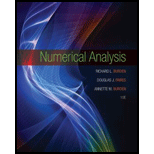
Numerical Analysis
10th Edition
ISBN: 9781305253667
Author: Richard L. Burden, J. Douglas Faires, Annette M. Burden
Publisher: Cengage Learning
expand_more
expand_more
format_list_bulleted
Concept explainers
Textbook Question
Chapter 4.1, Problem 8ES
The data in Exercise 6 were taken from the following functions. Compute the actual errors in Exercise 6 and find error bounds using the error formulas.
- a. f (x) = e2x – cos 2x
- b. f (x) = ln (x + 2) − (x + 1)2
- c. f (x) = x sin x + x2 cos x
- d. f (x) = (cos 3x)2 − e2x
6. Use the most accurate three-point formula to determine each missing entry in the following tables.
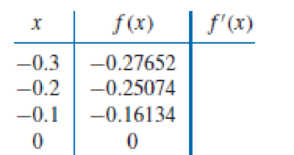
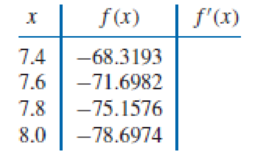
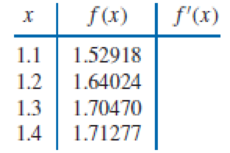
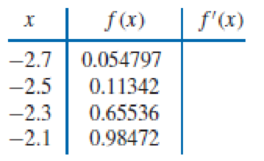
Expert Solution & Answer
Want to see the full answer?
Check out a sample textbook solution
Students have asked these similar questions
A retail store manager claims that the average daily sales of the store are $1,500.
You aim to test whether the actual average daily sales differ significantly from this claimed value.
You can provide your answer by inserting a text box and the answer must include:
Null hypothesis,
Alternative hypothesis,
Show answer (output table/summary table), and
Conclusion based on the P value.
Showing the calculation is a must. If calculation is missing,so please provide a step by step on the answers
Numerical answers in the yellow cells
.
The students who attend Memorial High School have a wide variety of extra-curricular activities to choose from in the after-school program. Students are 38% likely to join the dance team; 18% likely to participate in the school play; 42% likely to join the yearbook club; and 64% likely to join the marching band. Many students choose to participate in multiple activities. Students have equal probabilities of being freshmen, sophomores, juniors, or seniors.What is the probability of the union of being either a freshman or senior?
0.07
0.44
0.50
0.25
Explain the conditions under which the Radius of Convergence of the Power Series is a "finite positive real number" r>0
Chapter 4 Solutions
Numerical Analysis
Ch. 4.1 - Use the forward-difference formulas and...Ch. 4.1 - The data in Exercise 1 were taken from the...Ch. 4.1 - Use the most accurate three-point formula to...Ch. 4.1 - Use the most accurate three-point formula to...Ch. 4.1 - The data in Exercise 5 were taken from the...Ch. 4.1 - The data in Exercise 6 were taken from the...Ch. 4.1 - Prob. 9ESCh. 4.1 - Use the formulas given in this section to...Ch. 4.1 - The data in Exercise 9 were taken from the...Ch. 4.1 - Prob. 12ES
Ch. 4.1 - Use the following data and the knowledge that the...Ch. 4.1 - Prob. 14ESCh. 4.1 - Prob. 15ESCh. 4.1 - Prob. 16ESCh. 4.1 - Prob. 17ESCh. 4.1 - Prob. 18ESCh. 4.1 - Prob. 19ESCh. 4.1 - Prob. 20ESCh. 4.1 - Prob. 21ESCh. 4.1 - In a circuit with impressed voltage (t) and...Ch. 4.1 - In Exercise 9 of Section 3.4, data were given...Ch. 4.1 - Derive an O(h4) five-point formula to approximate...Ch. 4.1 - Use the formula derived in Exercise 24 and the...Ch. 4.1 - a. Analyze the round-off errors, as in Example 4,...Ch. 4.1 - Derive a method for approximating f (x0) whose...Ch. 4.1 - Consider the function e(h)=h+h26M, where M is a...Ch. 4.1 - Prob. 1DQCh. 4.1 - Prob. 2DQCh. 4.2 - Apply the extrapolation process described in...Ch. 4.2 - Add another line to the extrapolation table in...Ch. 4.2 - The following data give approximations to the...Ch. 4.2 - Prob. 6ESCh. 4.2 - Prob. 7ESCh. 4.2 - The forward-difference formula can be expressed as...Ch. 4.2 - Prob. 9ESCh. 4.2 - Prob. 10ESCh. 4.2 - Prob. 11ESCh. 4.2 - Prob. 12ESCh. 4.2 - Prob. 13ESCh. 4.3 - Approximate the following integrals using the...Ch. 4.3 - Approximate the following integrals using the...Ch. 4.3 - Find a bound for the error in Exercise 1 using the...Ch. 4.3 - Prob. 4ESCh. 4.3 - Repeat Exercise 1 using Simpsons rule. 1....Ch. 4.3 - Prob. 6ESCh. 4.3 - Prob. 7ESCh. 4.3 - Prob. 8ESCh. 4.3 - Prob. 9ESCh. 4.3 - Prob. 10ESCh. 4.3 - Prob. 11ESCh. 4.3 - Prob. 12ESCh. 4.3 - The Trapezoidal rule applied to 02f(x)dx gives the...Ch. 4.3 - Prob. 14ESCh. 4.3 - Approximate the following integrals using formulas...Ch. 4.3 - Prob. 17ESCh. 4.3 - Suppose that the data of Exercise 17 have...Ch. 4.3 - Prob. 19ESCh. 4.3 - Prob. 20ESCh. 4.3 - The quadrature formula...Ch. 4.3 - The quadrature formula...Ch. 4.3 - Find the constants c0, c1, and x1 so that the...Ch. 4.3 - Find the constants x0, x1, and c1 so that the...Ch. 4.3 - Prob. 25ESCh. 4.3 - Prob. 26ESCh. 4.3 - Prob. 27ESCh. 4.3 - Derive Simpsons Three-Eighths rule (the closed...Ch. 4.3 - Prob. 1DQCh. 4.3 - Prob. 2DQCh. 4.4 - Use the Composite Trapezoidal rule with the...Ch. 4.4 - Prob. 2ESCh. 4.4 - Use the Composite Simpsons rule to approximate the...Ch. 4.4 - Prob. 4ESCh. 4.4 - Prob. 5ESCh. 4.4 - Prob. 6ESCh. 4.4 - Prob. 7ESCh. 4.4 - Prob. 8ESCh. 4.4 - Prob. 9ESCh. 4.4 - Prob. 10ESCh. 4.4 - Determine the values of n and h required to...Ch. 4.4 - Repeat Exercise 11 for the integral 0x2cosxdx. 11....Ch. 4.4 - Determine the values of n and h required to...Ch. 4.4 - Repeat Exercise 13 for the integral 12xlnxdx. 13....Ch. 4.4 - Prob. 15ESCh. 4.4 - Prob. 17ESCh. 4.4 - A car laps a race track in 84 seconds. The speed...Ch. 4.4 - Prob. 19ESCh. 4.4 - Prob. 20ESCh. 4.4 - Prob. 21ESCh. 4.4 - Prob. 23ESCh. 4.4 - Prob. 24ESCh. 4.4 - Prob. 25ESCh. 4.4 - Prob. 26ESCh. 4.4 - Prob. 1DQCh. 4.4 - Prob. 2DQCh. 4.5 - Use Romberg integration to compute R3, 3 for the...Ch. 4.5 - Use Romberg integration to compute R3, 3 for the...Ch. 4.5 - Prob. 3ESCh. 4.5 - Prob. 4ESCh. 4.5 - Use the following data to approximate 15f(x)dx as...Ch. 4.5 - Prob. 9ESCh. 4.5 - Prob. 10ESCh. 4.5 - Prob. 11ESCh. 4.5 - Romberg integration for approximating 01f(x)dx...Ch. 4.5 - Prob. 15ESCh. 4.5 - Prob. 18ESCh. 4.5 - Prob. 19ESCh. 4.5 - Prob. 1DQCh. 4.5 - Prob. 4DQCh. 4.6 - Prob. 1ESCh. 4.6 - Prob. 2ESCh. 4.6 - Prob. 11ESCh. 4.6 - Prob. 12ESCh. 4.6 - Could Romberg integration replace Simpsons rule in...Ch. 4.7 - Approximate the following integrals using Gaussian...Ch. 4.7 - Approximate the following integrals using Gaussian...Ch. 4.7 - Repeat Exercise 1 with n = 3. 1. Approximate the...Ch. 4.7 - Repeat Exercise 2 with n = 3. 2. Approximate the...Ch. 4.7 - Repeat Exercise 1 with n = 4. 1. Approximate the...Ch. 4.7 - Repeat Exercise 2 with n = 4. 2. Approximate the...Ch. 4.7 - Repeat Exercise 1 with n = 5. 1. Approximate the...Ch. 4.7 - Repeat Exercise 2 with n = 5. 2. Approximate the...Ch. 4.7 - Describe the differences and similarities between...Ch. 4.7 - Prob. 2DQCh. 4.8 - Prob. 1DQCh. 4.8 - Prob. 2DQCh. 4.8 - Prob. 3DQCh. 4.8 - Prob. 4DQCh. 4.9 - Suppose a body of mass m is traveling vertically...Ch. 4.9 - The Laguerre polynomials {L0(x), L1(x) ...} form...Ch. 4.9 - Prob. 7ESCh. 4.9 - Prob. 8ESCh. 4.9 - Prob. 9ESCh. 4.9 - Prob. 1DQCh. 4.9 - Prob. 2DQ
Additional Math Textbook Solutions
Find more solutions based on key concepts
1. How much money is Joe earning when he’s 30?
Pathways To Math Literacy (looseleaf)
In Exercises 5-36, express all probabilities as fractions.
23. Combination Lock The typical combination lock us...
Elementary Statistics
In Exercises 9-20, use the data in the following table, which lists drive-thru order accuracy at popular fast f...
Elementary Statistics (13th Edition)
For Problems 23-28, write in simpler form, as in Example 4. logbFG
Finite Mathematics for Business, Economics, Life Sciences and Social Sciences
Testing Hypotheses. In Exercises 13-24, assume that a simple random sample has been selected and test the given...
Elementary Statistics Using The Ti-83/84 Plus Calculator, Books A La Carte Edition (5th Edition)
Knowledge Booster
Learn more about
Need a deep-dive on the concept behind this application? Look no further. Learn more about this topic, subject and related others by exploring similar questions and additional content below.Similar questions
- No chatgpt pls will upvotearrow_forwardQ/By using Hart man theorem study the Stability of the critical points and draw the phase portrait of the system:- X = -4x+2xy - 8 y° = 4y² X2arrow_forwardThis means that when the Radius of Convergence of the Power Series is a "finite positive real number" r>0, then every point x of the Power Series on (-r, r) will absolutely converge (x ∈ (-r, r)). Moreover, every point x on the Power Series (-∞, -r)U(r, +∞) will diverge (|x| >r). Please explain it.arrow_forward
- Q1: A slider in a machine moves along a fixed straight rod. Its distance x cm along the rod is given below for various values of the time. Find the velocity and acceleration of the slider when t = 0.3 seconds. t(seconds) x(cm) 0 0.1 0.2 0.3 0.4 0.5 0.6 30.13 31.62 32.87 33.64 33.95 33.81 33.24 Q2: Using the Runge-Kutta method of fourth order, solve for y atr = 1.2, From dy_2xy +et = dx x²+xc* Take h=0.2. given x = 1, y = 0 Q3:Approximate the solution of the following equation using finite difference method. ly -(1-y= y = x), y(1) = 2 and y(3) = −1 On the interval (1≤x≤3).(taking h=0.5).arrow_forwardФ sketch stability x= -4x + 2xy - 8 y° = 4 y 2 - x² чуг.arrow_forward2 Q/Given H (x,y) = x² + y² - y² Find the Hamiltonian System and prove it is first integral-arrow_forward
- Q2) A: Find the region where ODEs has no limit cycle: x = y + x³ y=x+y+y³ 6arrow_forwardQ3)A: Given H(x,y)=x2-x+ y²as a first integral of an ODEs, find this ODES corresponding to H(x,y) and show the phase portrait by using Hartman theorem and by drawing graph of H(x,y)-e. Discuss the stability of critical points of the corresponding ODEs.arrow_forwardQ/ Write Example is First integral but not Conservation system.arrow_forward
arrow_back_ios
SEE MORE QUESTIONS
arrow_forward_ios
Recommended textbooks for you

 Trigonometry (MindTap Course List)TrigonometryISBN:9781337278461Author:Ron LarsonPublisher:Cengage LearningAlgebra & Trigonometry with Analytic GeometryAlgebraISBN:9781133382119Author:SwokowskiPublisher:Cengage
Trigonometry (MindTap Course List)TrigonometryISBN:9781337278461Author:Ron LarsonPublisher:Cengage LearningAlgebra & Trigonometry with Analytic GeometryAlgebraISBN:9781133382119Author:SwokowskiPublisher:Cengage


Trigonometry (MindTap Course List)
Trigonometry
ISBN:9781337278461
Author:Ron Larson
Publisher:Cengage Learning

Algebra & Trigonometry with Analytic Geometry
Algebra
ISBN:9781133382119
Author:Swokowski
Publisher:Cengage
Limits and Continuity; Author: The Organic Chemistry Tutor;https://www.youtube.com/watch?v=9brk313DjV8;License: Standard YouTube License, CC-BY